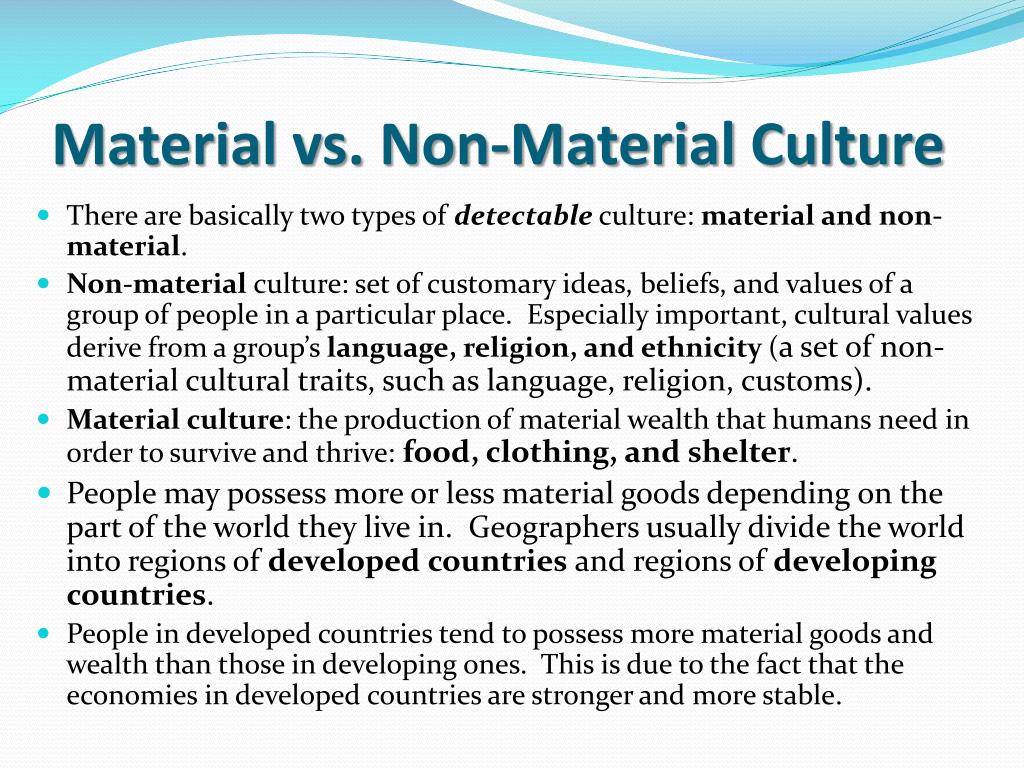Imagine walking into a bustling marketplace in a foreign country. The vibrant colours, the aroma of exotic spices, the sounds of haggling vendors – all these sensory experiences engulf you. You might find yourself drawn to the intricate patterns on a handwoven tapestry or captivated by the rhythm of a local dance. But what you may not realise is that you are experiencing two distinct yet interconnected facets of culture: material and non-material.

Image: ar.inspiredpencil.com
This article delves into the fascinating world of material and non-material culture, revealing how they work together to shape our identities, values, and interactions. You’ll learn how these two intertwined forces impact our lives, from the food we eat to the beliefs we hold, and how understanding them can foster greater empathy and appreciation for different cultures.
Material Culture: The Tangible World We Build
Material culture encompasses the physical objects and artifacts that define and represent a culture. It’s everything we can touch and see, from the ancient pyramids of Egypt to the latest smartphones. These objects are not merely decorative; they serve as tangible embodiments of a culture’s beliefs, values, and practices.
Imagine, for example, the intricate statues and elaborate temples of ancient Rome, representing the Romans’ deep devotion to their gods. Similarly, the modern-day skyline of New York City, with its skyscrapers and bustling streets, reflects the values of ambition, progress, and efficiency that are central to American culture.
Material culture can be anything from everyday objects like clothing and furniture to complex structures like buildings and monuments. Each object carries with it a story, a history, and a significance that speaks to the unique character of its cultural context.
Non-Material Culture: The Invisible Tapestry of Ideas
While material culture is the tangible canvas of a society, non-material culture forms the invisible threads that weave its fabric. It comprises the intangible aspects of a culture, including beliefs, values, customs, traditions, behaviours, language, and knowledge. It shapes our worldview, influencing our perceptions, decisions, and interactions.
Consider the tradition of bowing in Japanese culture. This custom reflects the values of respect, humility, and deference, deeply embedded in Japanese societal norms. Or take the shared belief in a divine creator in many religions; this intangible concept impacts individual behaviour and social interactions, shaping everything from moral codes to rituals.
Non-material culture is far more than a set of abstract ideas; it serves as the invisible blueprint that guides our actions and shapes our understanding of the world. It dictates how we interact with each other, how we raise our children, and how we navigate the world around us.
The Dynamic Interplay: How Material and Non-Material Culture Shape Our Lives
Material and non-material culture are not isolated entities; they exist in a symbiotic relationship, constantly influencing and shaping each other. The ways we interact with and interpret material objects are often informed by our non-material beliefs and values. For example, the reverence with which many Hindus treat their sacred cows is a cultural belief that impacts the material culture surrounding animal welfare and food practices.
Conversely, material objects can also reinforce and solidify non-material cultural values. The traditional tea ceremony in Japan, for instance, is not just about consuming a beverage but a ritualistic practice that embodies values of harmony, mindfulness, and respect for tradition. The intricate teacups, the carefully measured tea, and the meticulous preparation create a tangible experience that reinforces these intangible beliefs.
Therefore, it’s essential to understand how both material and non-material elements contribute to the complexities of a particular culture. We cannot truly grasp the significance of a society’s physical objects without considering the underlying beliefs and values that they represent.

Image: historyplex.com
Building Bridges of Understanding: The Importance of Cultural Sensitivity
Understanding both material and non-material culture is crucial for fostering empathy and building bridges across cultures. When we recognize the inherent value and meaning behind a culture’s tangible and intangible elements, we can begin to appreciate its richness and complexity.
For example, when travelling to a new country, it is essential to be respectful of local customs and traditions. Recognizing the symbolism behind certain clothing, dietary practices, or social gestures can prevent misunderstandings and foster meaningful connections with individuals from different backgrounds.
Embracing the Diversity of Human Experience
Exploring material and non-material culture opens up a window into the vast diversity of human experience. We begin to see that different cultures express themselves in unique ways, with varying perspectives, values, and practices. This understanding allows us to move beyond superficial differences and recognize the shared humanity that unites us all.
Material And Non Material Culture
Moving Forward: Embracing Cultural Understanding
By delving deeper into the world of material and non-material culture, we can gain a profound appreciation for the tapestry of human experience. Recognizing the importance of both tangible and intangible aspects of culture empowers us to interact with others with greater understanding, sensitivity, and respect.
So let us explore the fascinating world of cultures around us with open minds and curious hearts. Let us see beyond the surface and delve into the deeper meaning of the objects, customs, and beliefs that shape our lives and the lives of others.






